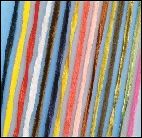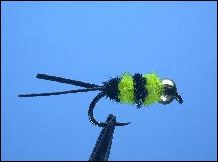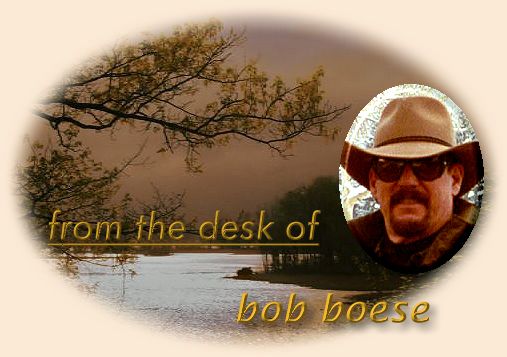|
(Generic flies are simple-to-tie patterns that a novice tyer
can easily accomplish and which requires less than four
dressing components.)
Some fishermen get to use manly terms when discussing their
angling passion. Things like lead sinkers, and hard wire leaders,
and size 6/0 hooks, and gaffs and billies, and drag (well maybe
not that). In contrast, fly fishermen get to talk about split bamboo,
and maribou, and krystal flash, and beads and chenille and nippers
and tippet. Ouch!
A Roman scholar, Claudius Ælianus, and his conqueror buddies
were traipsing through Macedonia in the 2nd or 3rd Century when he
noticed the locals fishing. He later described them using bug-shaped
wool and feather lures. Note, the Romans were doing the crushing and
destroying while the locals were doing the fly fishing. Not a good omen.
For the next 1200 years we can suspect that fishing for survival wasn't
very artistic, but there were a lot of sheep and chickens available. Then,
in 1496, the prioress of an abbey is credited with writing A Treatyse
of Fysshynge wyth an Angle which gave specific details about the
construction and use of fishing equipment, including artificial flies. (There is
debate about authorship of the Treatyse, and admittedly, it would have been
nice to learn that the author was Sir Bicep the Potent.) Regardless, some time
later, in 1653, Isaak Walton wrote The Compleat Angler
and is credited for describing 60 fly patterns, although it took till the 5th
edition and work of his student, Charles Cotton, for the book to mention it.
(It is unfortunate for our cause that Walton, once an Ironmonger, became a
drapery salesman.) Next thing you know, some Spaniard steals worms from
China and European fly fishermen began tipping their macho horsehair lines
with silk leaders until World War II and the advent of nylon. Meanwhile,
back in the late 1800s, British nobles and gentlemen, who were always
rather particular, having recently discovered the dry-fly, decided that they
despised any fly that wasn't a floating insect replica. Stodgy owners of
English fishing waters actually banned nymphs – from the boudoir
and the stream. Eventually, many socially unacceptable non-dry fly fishermen
immigrated to America and brought along their fly fishing techniques. Another
100 years pass and, waiting around for D-Day, the GIs successfully trolled
for sweet young things and bad old trout with silk and nylon until the stuffy
nymph and Yank-despising Englishmen reluctantly delved into actual romance
and fished wet flies.
While conventional Brits considered "wet flies" to mean a bladder failure,
it actually describes any non-floating fly that is not a streamer or nymph.
"Streamers" are feather or bucktail winged patterns that represent fish,
while "nymphs" represent – no, not that – the aquatic stage
of insects. As the GIs knew, both warm and cold water species eat
aquatic insects frequently and in great numbers. Trout can be ridiculously
selective, and with almost religious zealotry, today's nymph fishermen insist
that a pattern must closely match the predominant insect species in the water
being fished. (Which is sort of silly, since many dubbed nymphs look like a
dust bunny or hairball.) On the other hand, while precise replication may
be helpful for cold streams with selective or over-fished rainbows, warm
water species are much less discriminating. Consequently, it is foolish for
any angler not to have generic wet flies or nymphs available in a bass/panfish
fly fishing arsenal.
A difficulty with tying many trout nymph patterns is their size. Other than
large stones, hexes and dragonflies (the T-Rex of nymphs), patterns can
call for sizes in the 18 to mid-20s, with tiny hooks that are barely visible
to the naked eye and unforgiving of any masculine meat hook tying
approach. Many patterns also call for advanced tying techniques like
weaving (don't go there) or dubbing uncooperative materials or attaching
difficult components to achieve adequate resemblance to the nymph de jour.
Fortunately, warm water fish are not so particular and they roam a pond
like grocery aisles with one thought in mind – "It's all good." More
importantly, panfish and bass do not require microscopic flies and a more
macho size 14 is as small as need be tied, more likely a husky 10 -12. The
really good news is that the larger the fly, the more room for tying error.

Admittedly, while dressing a fly with remnants of dead things may
seem virile, chenille makes tying much easier. As opposed to
dubbing loose fur, chenille comes in long strips, ready to apply,
and is very forgiving. Chenille was created in the 1830s and at
the turn of the 20th century was one of the most popular materials
for soft feminine bedspreads and in the 50s was incorporated into
fluffy carpets. One saving grace is that, for many decades, chenille
was mostly seen encasing a metal stem for pipe cleaners. Then, in
the 1970s, the Wapsi Company set up headquarters in Mountain
Home, Arkansas (by the famous White River full of man-sized
browns) and began manufacturing a line of fly tying materials,
including chenille, plus a tight nap chenille they called "ultra". Next
came flashy products such as "crystal chenille" and "estaz," adding
more movement and flash to the basic chenille product. Today,
hundreds of varieties of chenille are sold by a multitude of
manufacturers, in fabric stores (shudder) and fly shops, and
each one can have some use in fly tying.
In selecting a chenille fly, the first consideration might be color.
Chenille is available in a wide spectrum and, while it may be
tempting for some to tie a fuchsia and pink striped pattern, the
better option is to stick with something more likely to be owned
by a male, and to be found on creatures usually in the water.
Chenille is the principal ingredient of Woolly Buggers and
Woolly Worms, which are addressed in Part V of this series.
Nymphs appear in many colors, sometimes variegated, usually
tending toward warmer hues of browns, reds and yellow/tans.
Streamers should be fish colored and wet flies can be anything
the tyer's imagination and common sense tells him is buggish.
Weight is another option. Wet flies are meant to be fished
below the surface, and how far below is a factor of fly weight
versus resistance/buoyancy of the leader/tippet. Many tyers
prefer to put a metal bead on the head of the fly (tungsten has
a nice sound to it) which makes the fly fall head first. Or better
yet, or underwrap the fly with practically illegal lead wire.
Then use it to catch big fish with names like bass or crappie.

JITTERBEE (by Randy Leonpacher)
Hook: Size 8-10, Dai-Riki #305 or equivalent.
Thread: Flat waxed nylon or 6/0.
Tail: Black silicone skirt material.
Head: Gold metal bead.
Body: Chenille in contrasting colors.
1. Put bead on hook and thread it to the hook eye.
2. Wrap hook shank with thread to form base for other materials.
3. Take two short pieces of silicone skirt and hold them
flat sides together. Slide them over the hook shank and
wrap with thread leaving a tag end slightly shorter than the
hook shank. Using this tie-in method, when you release the
silicone it should flare to a "V" shape. If it doesn't, do a
couple of figure 8 wraps over the skirt pieces to separate the tail.
4. Tie in two contrasting colors of chenille and move
thread to behind the bead.
5. Hold the two pieces of chenille together and wrap
clockwise to the bead and tie down. Cut off excess chenille.
6. Whip finish smoothly behind the bead.
7. Pull back the chenille to allow you to put a drop of Hard
As Nails on the whip finished thread.
Chenille yarn consists of short lengths of spun yarn or filament that
are held together by two ends of highly twisted fine strong yarn.
The short lengths are called the pile and the highly twisted yarns
are called the core. Chenille yarn can be made from many
different types of fibers and yarns. Most common are cotton,
viscose (rayon), acrylic, and polypropylene (olefin). ~ Bob
About Bob:
Robert Lamar Boese has fly fished for five decades. He is an
environmental negotiator, attorney and educator who has provided
environmental legal services for more than thirty-three years including
active duty with the U.S. Coast Guard and Department of Justice. He is a
well known fly tyer with several unique patterns to his credit. He has
developed and authored federal and state regulatory programs
encompassing a broad spectrum of environmental disciplines, has
litigated environmental matters at all levels of the federal and state
court systems, and is a qualified expert for testimony in environmental
law. He has authored over 60 published text chapters, comments or
articles on environmental matters, is a member of the Colorado, District
of Columbia and Louisiana Bar Associations, and is a certified mediator.
In addition to his legal practice, Mr. Boese has been a high school
teacher, an associate professor of Environmental Law and Public Health,
has authored numerous fiction and sports publications, and is a softball
coach and nationally certified volleyball referee. He is the president
of the Acadiana Fly Rodders in Lafayette, Louisiana and editor of
Acadiana on the Fly. He has been married for thirty years and is the
father of two fly fishing girls (25 and 21). For additional information
contact: Boese Environmental Law, 103 Riviera Court, Broussard, LA 70518
or call 337.856.7890 or email coachbob@ymail.com.
|



